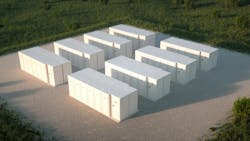Ofgem Launches Cap and Floor Investment Support Scheme to Build Long Duration Electricity Storage Projects
Ofgem has launched a new cap and floor investment support scheme to build Long Duration Electricity Storage (LDES) projects.
The UK Government, advised by National Energy Systems Operator (NESO), has identified the expansion of LDES to achieve clean power by 2030 and the drive to reach net zero by 2050.
Ofgem's scheme will boost investor confidence with the security of providing minimum revenue for LDES operators to manage high start-up costs and long build times. The scheme will reduce costs, allowing efficient projects with a storage capacity of more than eight hours. The regime will protect consumers with a cap on profits, meaning any excess revenues flow directly back to customers through their bills.
The plan builds on Ofgem’s electricity interconnector cap and floor model which was successful in attracting investment and protecting consumers, delivering $256.4 million back to customers through reduced bills, since 2014.
NESO, in its Future Energy Scenarios report, has advised the Government to add an indicative range of 2.7 to 7.7 GW of stored power by 2035. The addition will double Great Britain’s existing strategic reserve of 2.8 GW spread across four pumped storage hydro schemes in Scotland and Wales.
According to the government analysis, 20 GW of LDES, the current target set for 2050, is expected to save the electricity system $30.77 billion between 2030 and 2050, minimizing household energy bills as additional cheap renewable energy will reduce reliance on natural gas.
“This scheme is a step towards realising the long-term vision for achieving the government's decarbonisation and energy security ambitions,” said David Boyer, Director Electricity System, Energy Networks Association (ENA). “The electricity networks have been working closely with Ofgem and government to reform the connections queue and secure the long-term investment needed to achieve clean, secure power and protect consumers from future energy shocks."
Developers of LDES will work with the communities hosting their projects to get the necessary permits and consents before any progress on the projects. The launch of the LDES scheme is followed by other steps by Ofgem including grid connection reform to accelerate shovel-ready clean energy projects and the creation of five major new undersea energy links, or interconnectors, to further harness the potential of North Sea wind for powering homes.
